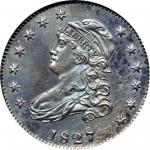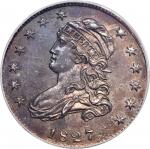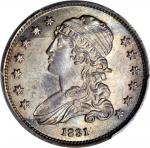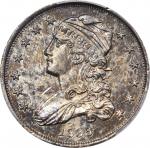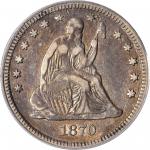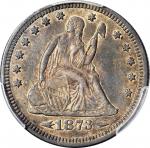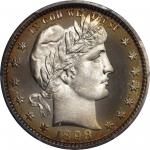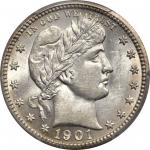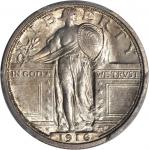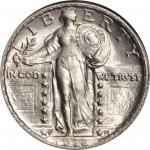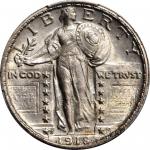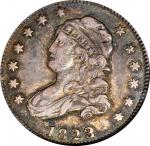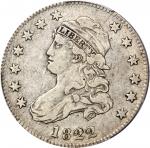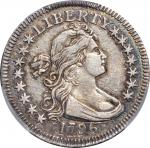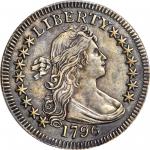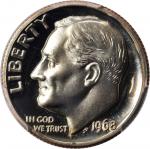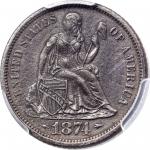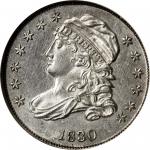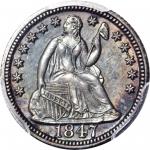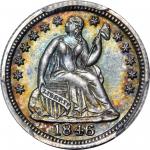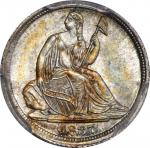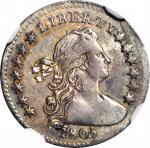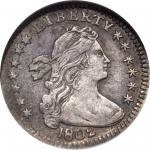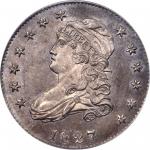1827/3/2 Capped Bust Quarter. Original. B-1. Rarity-7. Curl Base 2 in 25 C. Proof-65 Cameo (PCGS). CAC. In the Pantheon of the most famous and eagerly sought American numismatic rarities, perhaps no other coin is as enigmatic as the Original 1827 quarter. The beginnings of these coins are shrouded in mystery and have been the subject of conjecture and debate since the issue first became known to the wider numismatic community in the years immediately preceding the Civil War. Even the earliest provenance of several examples is speculative, at best, and pure fantasy, at worst. In the absence of documentary evidence, all that todays researchers are left with is a combination of fantasy and lore that has become part of "traditional numismatic wisdom," along with more scholarly, yet still conjectural theories regarding the production and initial distribution of these coins. No offering of an Original 1827 quarter would be complete without a survey of the numismatic literature over the years.
The Story of the Original 1827/3/2 Quarter</strong>
Ironically, the story of this now-famous issue begins with a fact: per the Mint Directors report, 4,000 quarters were delivered to the Mint Treasurer on December 29, 1827, representing the Mints entire mintage of quarters for calendar year 1827 and, indeed, its first production for this denomination since 1825. It is the mintage figure reported for the 1827-dated Capped Bust quarter in most of todays standard numismatic references, including <em>A Guide Book of United States Coins</em> (the popular "Red Book") originally authored by R.S. Yeoman. The existence of so few examples, however, has cast a long shadow of doubt about the relevance of this mintage figure to the 1827-dated Capped Bust quarter issue.
Indeed, numismatic scholars of the 20th and early 21st centuries are nearly unanimous in their conclusion that this 4,000-piece mintage figure has nothing to do with the 1827-dated quarter. Some, such as Jeff Garrett and Ron Guth in the popular reference <em>100 Greatest U.S. Coins</em> (Fifth Edition, 2019), describe it as "erroneous." Others believe that it is a genuine mintage figure, as reported by the Mint Director, but assert that it represents a delivery of quarters bearing a date other than 1827. In his various writings, Walter Breen conjectures that it refers to one final delivery of 1825-dated quarters. More recently Karl Moulton, in an article adapted and updated for inclusion in Steve M. Tompkins 2008 book <em>Early United States Quarters: 1796-1838</em>, concludes that these 4,000 coins represent the Mints initial delivery of 1828-dated quarters. Moulton points out that, during the waning days of 1827, it would have been much more logical for the Mint to use new dies that had been prepared in anticipation of coinage during calendar year 1828, as opposed to old dies that had not been used since 1825.
If no 1827-dated quarters were included in the Mints 4,000-piece delivery of December 29, 1827, how is it that coins bearing this date, albeit few in number, are known today? After all, and as previously stated, there is no documentary evidence for the Mints striking of 1827 quarters, either during that or any other year. This omission, in its own right, is strongly suggestive of the special nature of these coins. Whereas (and with very few exceptions) yearly mintages for regular issue circulation strike coinage was reported by the Mint Director, the same did not happen for Proof gold and silver coinage until 1859, with Proof minor coinage not reported until 1878. Prior to the late 1850s, the Mint did not record the number of Proof silver coins struck during any given year. In all cases such coins were produced in very limited numbers, and in a few special cases for presentation or other official purposes. (The Class I 1804 silver dollars struck in 1834, the fabulous Sultan of Muscat specimen of which are also offering in this sale, is an outstanding example of a Proof issue struck for presentation purposes by the early United States Mint.) While the 1827 quarters that were actually struck that year were almost certainly not intended for presentation purposes, they were still produced in small numbers, are of superior workmanship to circulation strikes of the era, and with only a single exception are expertly preserved to suggest special distribution.
Karl Moulton has established that the only known obverse die of the 1827-dated quarter is the same that the Mint previously used to strike the nearly as rare and perhaps equally famous 1823/2 quarter, an example of which we are also offering in this sale. Although opinions differ as to why, in 1827 Mint employees retrieved the 1823/2 obverse die, which theoretically would have been in excellent condition given the small mintage of that issue, and prepared it for 1827-dated coinage. This process included a curious feature: in contrast to other overdates, produced by punching over only the final digit, all four digits have been re-punched with current punches, the 1, 8, and 2 being identical to those used on the quarters of 1828. This provides support for the theory that at least one 1828-dated obverse was also prepared in 1827 and, as Moulton asserts, was used for the 4,000-piece circulation strike delivery of December 29, 1827. All genuine 1827 quarters, regardless of striking period, exhibit an unusual and corroded texture on the bust of Liberty. This is consistent with an overuse of acid on the face of the die, perhaps to clean this obverse after four years spent in storage and in preparation for its use in 1827-dated coinage.
This obverse die, now overdated a second time as 1827/3/2, was paired with a fresh reverse die to strike quarters toward the end of 1827. This is the variety now known as Browning-1, the Original 1827 quarter. Exactly when this took place, for what purpose, and to what extent are unknown. Breen provides a mintage figure of 12 pieces, but without providing any support for such a figure. Only nine examples are known and, in fact, this figure probably represents the entire mintage from the B-1 die pairing. Karl Moulton uses this number as the foundation of an interesting theory:
"I believe that late on the afternoon of Christmas eve [1827] Director [Samuel] Moore authorized a few special 1827 open collar Christmas presents to be clandestinely made in honor of the Officers of the Mint; including one for Mr. [Christian Gobrecht] and the Secretary of the Treasury in Washington D.C.
"This list numbers eight people, which just happens to be the correct number of these...Original pieces traced by the author, excluding the example placed in the Mint Collection, where it remains today.
"1. Samuel Moore - Director
"2. James Rush - Treasurer
"3. Joseph Richardson - Assayer
"4. Adam Eckfeldt - Coiner
"5. Joseph Cloud - Melter & Refiner
"6. William Kneass - Engraver
"7. Christian Gobrecht - Creator of the 1827/3/2 die
"8. Richard Rush - Secretary of the Treasury"
Again, this is just a theory and lacks documentary evidence. That these B-1 coins were struck in 1827 and deserve the title of Originals is beyond doubt, however, and for two reasons. First, they were obviously struck prior to the 1828 B-1 circulation strikes, which were coined from the same reverse die. In both the 1827 B-1 and 1828 B-1 pairings this die is cracked at top, from the border through the letters ED in UNITED, across the top of the scroll, under the letter F in OF, through the base of the letter A and the centers of the letters ME in AMERICA. This crack almost certainly formed during hardening of this die. In the later 1828 B-1 pairing, however, an additional crack developed in this reverse die: from the lower left border, through the tips of the outmost leaves, and back to the border outside the U in UNITED, with a short branch going to the letter. This break would eventually result in a retained cud that would force the Mint to retire this reverse die from production, although the obverse die of the 1828 B-1 pairing soldiered on to strike additional 1828-dated quarters of the B-2 and B-3 varieties.
Second, all genuine 1827 B-1 quarters have 108 edge reeds, which matches the count seen on the other quarters of this era. Clearly, the 1827 B-1 Original quarters were struck first, followed by the first of the 1828 B-1 circulation strikes, the latter probably representing the aforementioned 4,000-piece mintage reported for calendar year 1827. (Whether these B-1 coins are the first quarters struck from the 1827/3/2 obverse die is a matter of debate; see below in our description for the Restrike 1827/3/2 quarter offered in this sale.)
The status of the 1827 B-1 coins as Proofs is problematic, insofar as they do not meet the requirements for Proof coins as defined by modern numismatics. For one thing, these coins are not fully struck, as each example displays isolated softness to the design elements. They are probably more accurately described as "Master" coins, a term not widely used today, and which in the case of the Original 1827 quarters is most conveniently defined as coins struck from newly (re-)polished dies. Historically, however, and as with the legendary 1894-S Barber dimes, the Original 1827 quarters have always been regarded as Proofs, a classification that is likely to remain for the foreseeable future, if not for all time.
Regardless of the intent behind their production, it seems that the Original 1827 quarters did not see immediate distribution. This is contrary to one of the most widely known and often repeated stories relating to this famous issue, a tale that has a particularly strong link to the specimen offered here. As told by Walter Breen (<em>Encyclopedia</em>, 1988), who more than any other numismatic writer is responsible for giving this story currency in the modern market:
<em>"Joseph J. Mickley (1799-1878), Father of American Coin Collecting, obtained four proofs from the Philadelphia Mint in late 1827 as change for a dollar (presumably Spanish or Mexican); for decades these were the only ones known."</em>
As Karl Moulton points out, this story originated with A.M. Smith and was first printed shortly after Mickleys death in 1878. It was expanded upon by W. Elliot Woodward in the January 1884 Heman Ely sale catalog and, later, further embellished by Breen through his cataloging for New Netherlands. Unfortunately, there is no evidence that Mickley ever owned more than one 1827 quarter and, more significantly, the numismatic market was not aware of these coins existence until the late 1850s. Moulton identifies their first mention in literature as the September 13, 1857, issue of the <em>New York Dispatch</em>; by 1867 all nine specimens were known to the numismatic community. It seems likely that the Original 1827 quarters remained in the Mints possession until the 1850s. With the appointment of James Ross Snowden as Mint Director in June 1853, interest in growing the Mint Cabinet Collection reached new levels, and duplicates of a rare and previously unknown coin such as the 1827 quarter would have been prime candidates for trading with collectors for other items desired for the Mints holdings.
Through special, if unofficial distribution to contemporary numismatists, most of the nine Original 1827 quarters have remained in high grades to the present day. There is one noteworthy exception -- the Eliasberg specimen currently certified Proof-20 by PCGS. Rather than a survivor of a circulation strike 1827-dated quarter issue (4,000-piece mintage or otherwise) or a coin that was accidentally spent after being distributed by Mint employees, Karl Moulton makes a compelling argument that this coin was carried as a pocket piece by a previous owner. This "previous owner" was Lewis White, who acquired the coin from Edward Cogans October 1865 F.S. Edwards sale; its next market offering was in Cogans April 1876 sale of Whites collection.
<strong>The Mickley-Norweb Specimen of the Original 1827/3/2 Quarter</strong>
This is perhaps the most famous Original 1827 quarter, no doubt due to the aforementioned story about Joseph J. Mickley acquiring four Proof 1827 quarters directly from the Philadelphia Mint in late 1827 in change for a dollar. Inasmuch as this is the specimen included in W.E. Woodwards October 1867 sale of the Mickley Collection, this coin has long been described as "J.J. Mickleys Favorite" 1827 quarter. As previously stated, there is no evidence that Mickley ever owned more than one 1827 quarter, and even less evidence for his having acquired any 1827 quarters from the Mint in 1827. There is, however, likely a nugget of truth to this story. As one of the nine founding members of the Numismatic and Antiquarian Society of Philadelphia (along with other early 1827 quarter owners Arthur G. Coffin and John Bohlen), Mickley almost certainly acquired his specimen directly from the Mint, although most likely during the 1850s, and in trade for items desired for the Mint Cabinet Collection not as change for a dollar.
When offered in the 1867 Mickley Collection sale, this coin was lotted as part of a three-piece Proof "set" with an 1827 dime and half dollar, seemingly a concoction of Woodwards to create excitement among bidders. Selling to Joseph P. Reakirt, the coin appeared at the 1962 ANA Convention, and shortly after found its way into the collection of Ambassador and Mrs. R. Henry Norweb. It remained part of the Norweb holdings until sold in Part II of our (Bowers and Merenas) sale of the Norweb Collection, March 1988. Returning to auction in our (Bowers and Merenas) May 1993 Stetson University Collection sale, the coin then entered the renowned cabinet of Dr. William Morton-Smith, whose family has consigned it to the present auction. This sale of the famous Mickley-Norweb Original 1827/3/2 quarter is not the first time Stacks Bowers Galleries has worked with the family. Previously we were selected to bring to market Bills 1804 dollar, pedigreed to the Berg and Garrett collections; his 1794 dollar, the Lord St. Oswald/Norweb specimen; and the Eliasberg 1913 Liberty Head nickel.
A beautiful Gem-quality specimen of this classic Capped Bust quarter issue, this coin displays lovely iridescent toning over mirrored surfaces. The striking detail is sharp in virtually all areas, although it is not completely full, as is characteristic of the issue. Softness is extremely minor, however, and confined to the high point of Libertys cap, a few of the obverse stars, and several of the design elements around the periphery on the reverse. The diagnostic reverse die crack and roughness to Libertys bust are readily evident and, when taken in conjunction with the Curl Base 2 in the denomination, confirm this outstanding coin as an Original 1827/3/2 from the B-1 die pairing.
The offering of any 1827 quarter is a significant event, as it has been in earlier generations and will continue to be in the future. The Mickley-Norweb specimen is a particular treat for advanced collectors, as it is an outstanding Gem that ranks as the second finest-certified example behind the Garrett-Pogue specimen in PCGS Proof-66+ Cameo. On behalf of the Dr. William Morton-Smith family, Stacks Bowers Galleries is once again honored to offer this landmark rarity at auction. Ex Joseph J. Mickley; W. Elliot Woodwards sale of the Joseph J. Mickley Collection, October 1867, lot 1706, offered with a Proof 1827 dime and half dollar; Joseph P. Reakirt; Columbus Stamp & Coin, appeared at the 1962 ANA Convention; Ambassador and Mrs. R. Henry Norweb; our (Bowers and Merenas) sale of the Norweb Collection, Part II, March 1988, lot 1542; our (Bowers and Merenas) Stetson University Collection sale, May 1993, lot 224; Dr. William Morton-Smith.

